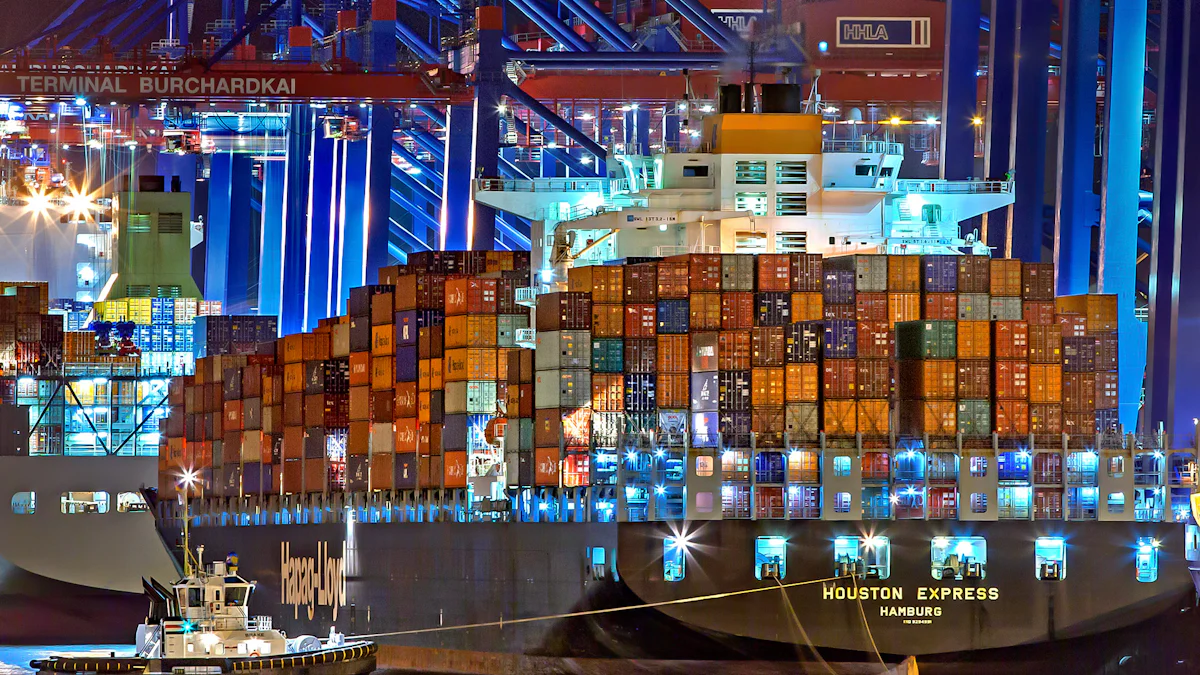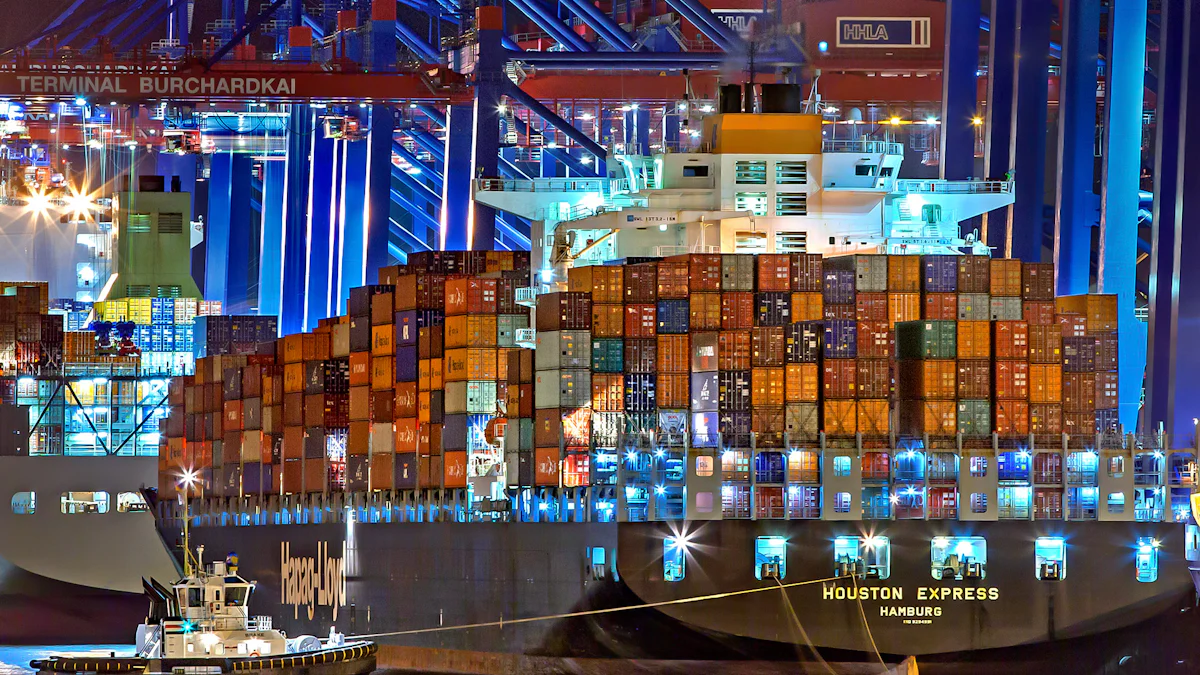2024 Predictions: Ocean Freight Market Dynamics

Ocean freight plays a critical role in global trade, with approximately 90 percent of global shipping relying on it. The volume of cargo transported by ships has surged from 4 billion tons in 1990 to 11 billion tons in 2021. Understanding market dynamics is crucial for strategic planning. Monitoring trends and expert insights helps stakeholders navigate complexities and capitalize on opportunities. The focus on 2024 predictions aims to provide valuable insights into the evolving landscape of the ocean freight market.
2024 Predictions: Current State of the Ocean Freight Market
Overview of 2023 Performance
Key Statistics and Trends
The ocean freight market experienced significant growth in 2023. The North American intermodal market saw an 11% year-over-year increase through March 2024. The international market grew by 18% year-over-year. The domestic market had a modest 0.9% year-over-year growth. Intermodal spot rates decreased by 5% year-over-year but are expected to turn positive by Q3 2024.
Analysts predict a growth rate of around 5% in the first half of 2024 for the global ocean freight market. Increased demand for consumer goods and industrial products contributed to this growth. Market fluctuations occurred due to geopolitical tensions and economic policies. Reliable freight rate forecasts remain crucial for market stability.
Major Events and Their Impact
Several major events shaped the ocean freight market in 2023. Geopolitical tensions influenced trade routes and shipping costs. Economic policies in key regions affected freight demand and supply chain dynamics. Technological advancements improved operational efficiency and reduced costs. Environmental regulations pushed companies to adopt sustainable practices.
Current Challenges and Opportunities
Supply Chain Disruptions
Supply chain disruptions posed significant challenges in 2023. Port congestion, labor strikes, and transportation bottlenecks caused delays and increased costs. Companies faced difficulties in maintaining inventory levels and meeting customer demands. The emphasis on supply chain resilience became more pronounced. Governments and companies focused on reshoring and nearshoring manufacturing to reduce dependency on foreign supply chains.
Emerging Markets
Emerging markets presented new opportunities in 2023. Regions such as Asia-Pacific led growth with a projected increase in container volumes by 3% to 4%. Companies expanded into markets like China-Europe, China-Russia, and China-ASEAN. New routes, including Japan/Taiwan-Vietnam and India, were explored to enhance service competitiveness. Investment in infrastructure and network development remained crucial for market expansion.
2024 Predictions: Supply and Demand Dynamics

Global Trade Patterns
Major Trade Routes
Major trade routes will continue to play a pivotal role in the ocean freight market. The Asia-Europe and Asia-North America routes handle a significant portion of global trade. The rise in e-commerce and demand for faster delivery times have increased the volume of goods transported by sea. The "China+1" strategy has led companies to diversify manufacturing bases, impacting shipping routes and volumes. Companies now utilize alternative routes to mitigate risks associated with geopolitical tensions.
Shifts in Trade Volumes
Shifts in trade volumes will reflect changing global economic conditions. Economic integration and geographical proximity influence these patterns. Companies diversify supply sources to reduce risks, affecting global trade flows. Disruptions at key ocean trade routes can significantly impact the global economy. For instance, trade tensions between major economies can disrupt supply chains and affect shipping volumes. Conversely, favorable trade agreements can stimulate trade and increase demand for ocean freight services.
Capacity and Fleet Developments
New Ship Orders and Deliveries
New ship orders and deliveries will shape fleet capacity in 2024. Carriers added capacity in 2023 and plan to do so again in 2024. Analysts predict a growth rate of around 5% in the first half of 2024 for the Ocean Transport market. The container ship fleet is forecasted to grow by 9.5% during 2024 and 4.9% during 2025, totaling 14.9% growth over the two years combined. Increased capacity aims to meet rising demand for consumer goods and industrial products.
Scrapping and Fleet Utilization
Scrapping and fleet utilization will also influence market dynamics. Older vessels will be scrapped to make way for newer, more efficient ships. This process helps maintain an optimal balance between supply and demand. Efficient fleet utilization ensures that carriers can meet market needs without excessive idle capacity. Companies focus on cost control and service enhancement to remain competitive. Consolidating cargo volumes and implementing pricing schemes are essential strategies.
2024 Predictions: Macroeconomic Factors
Economic Growth Projections
Impact of Global GDP on Freight Demand
Global GDP growth significantly influences freight demand. Economic expansion drives consumer spending and industrial production. Increased production and consumption lead to higher freight volumes. The North America Freight Insights journal highlights that GDP growth does not directly translate to trucking volumes. A deeper analysis is necessary to understand the correlation between GDP and ocean freight demand.
Freight demand often mirrors economic health. Robust GDP growth usually signals increased trade activities. Conversely, economic downturns can reduce freight volumes. The Global Ocean Freight Market Future Dynamics journal indicates that global trade patterns and economic policies shape the ocean freight market. Understanding these factors helps stakeholders predict freight demand more accurately.
Regional Economic Outlooks
Regional economic outlooks vary significantly. Asia-Pacific remains a key driver of global trade. Strong economic growth in countries like China and India boosts regional freight demand. Europe and North America also play crucial roles. Economic stability in these regions supports steady freight volumes.
Emerging markets present new opportunities. Africa and Latin America show promising growth prospects. Investments in infrastructure and trade agreements enhance these regions' economic potential. Companies expanding into these markets can capitalize on growing freight demand. Monitoring regional economic trends is essential for strategic planning.
Trade Policies and Regulations
Tariffs and Trade Agreements
Trade policies and regulations impact the ocean freight market. Tariffs influence shipping costs and trade volumes. Trade agreements facilitate smoother trade flows. The Global Ocean Freight Market Future Dynamics journal emphasizes that economic policies shape the ocean freight market. Understanding these policies helps stakeholders navigate complexities.
Tariffs can disrupt supply chains. Higher tariffs increase shipping costs, affecting profitability. Trade agreements, on the other hand, reduce barriers and promote trade. The "China+1" strategy exemplifies how companies diversify manufacturing bases. This strategy impacts shipping routes and volumes. Staying informed about trade policies is crucial for effective decision-making.
Environmental Regulations
Environmental regulations increasingly affect the ocean freight industry. Stricter regulations aim to reduce carbon emissions and promote sustainability. Companies must adopt eco-friendly practices to comply with these regulations. The Global Ocean Freight Market Future Dynamics journal notes that environmental regulations push companies to adopt sustainable practices.
Green shipping technologies and alternative fuels play vital roles. Companies investing in these innovations gain competitive advantages. Sustainable practices not only comply with regulations but also attract environmentally conscious customers. Monitoring regulatory changes helps companies stay ahead in the market.
2024 Predictions: Technological Advancements

Digitalization and Automation
Smart Shipping Solutions
Smart shipping solutions will revolutionize the ocean freight industry in 2024. Companies will adopt AI-driven models to enhance operational efficiency. The "Maritime Dynamic ETA Algorithm" will predict port arrival times with greater accuracy. This technology will also assess weather impacts and shipping risks. Early warning systems will detect anomalies in multimodal transport. These advancements will streamline international maritime shipping management.
Digital twins will play a crucial role in optimizing fleet operations. These virtual replicas of physical assets will provide real-time data. Operators will use this information to make informed decisions. Predictive maintenance will reduce downtime and extend vessel lifespans. Smart shipping solutions will lead to cost savings and improved service reliability.
Blockchain in Supply Chain
Blockchain technology will transform supply chain management in 2024. This technology will offer enhanced transparency and security. Each transaction will be recorded on an immutable ledger. Stakeholders will have access to real-time shipment data. This visibility will reduce fraud and improve trust among parties.
Smart contracts will automate various processes. These self-executing contracts will ensure compliance with agreed terms. Payments and documentation will be processed automatically. Blockchain will also facilitate efficient customs clearance. The technology will streamline cross-border trade and reduce delays.
Sustainability Innovations
Green Shipping Technologies
Green shipping technologies will gain prominence in 2024. Companies will invest in eco-friendly practices to comply with environmental regulations. Energy-efficient vessels will reduce carbon emissions. Advanced hull designs and propulsion systems will enhance fuel efficiency. Renewable energy sources, such as wind and solar power, will supplement traditional fuels.
Emission reduction technologies will play a vital role. Scrubbers will remove sulfur oxides from exhaust gases. Ballast water treatment systems will prevent the spread of invasive species. These innovations will help companies meet stringent environmental standards. Green shipping technologies will attract environmentally conscious customers.
Alternative Fuels
Alternative fuels will drive sustainability efforts in the ocean freight industry. Liquefied natural gas (LNG) will serve as a cleaner alternative to conventional fuels. LNG-powered vessels will emit fewer greenhouse gases. Biofuels will also gain traction as a renewable energy source. These fuels will be derived from organic materials, reducing the carbon footprint.
Hydrogen fuel cells will emerge as a promising technology. These cells will generate electricity through a chemical reaction. The only byproduct will be water, making hydrogen an environmentally friendly option. Companies will invest in research and development to advance these technologies. Alternative fuels will contribute to a greener and more sustainable ocean freight market.
2024 Predictions: Risks and Uncertainties
Geopolitical Risks
Trade Wars and Sanctions
Trade wars and sanctions will significantly impact the ocean freight market in 2024. Geopolitical tensions between major economies will disrupt shipping routes and increase costs. The "China+1" strategy will lead companies to diversify manufacturing bases, affecting trade volumes. Governments will impose tariffs and sanctions, creating uncertainty in supply chains. Companies must develop strategies to mitigate these risks. Monitoring geopolitical developments will be crucial for effective decision-making.
Political Instability in Key Regions
Political instability in key regions will pose challenges for the ocean freight industry. Countries experiencing political turmoil will face disruptions in port operations and logistics. Labor strikes and civil unrest will cause delays and increase operational costs. Companies must navigate these complexities to maintain supply chain efficiency. Investing in alternative routes and diversifying supply sources will help mitigate risks. Staying informed about political developments will be essential for strategic planning.
Natural Disasters and Climate Change
Impact on Shipping Routes
Natural disasters and climate change will affect shipping routes in 2024. Extreme weather events will disrupt maritime operations and cause delays. Hurricanes, typhoons, and floods will damage ports and infrastructure. Rising sea levels will impact coastal areas, affecting port accessibility. Companies must adapt to these changes to ensure smooth operations. Investing in resilient infrastructure will help mitigate the impact of natural disasters.
Mitigation Strategies
Mitigation strategies will be essential to address the challenges posed by natural disasters and climate change. Companies will invest in advanced weather forecasting systems to predict and avoid extreme weather events. Implementing robust contingency plans will help manage disruptions effectively. Sustainable practices will play a crucial role in reducing the industry's environmental footprint. Companies will adopt green technologies and alternative fuels to comply with environmental regulations. Collaboration with governments and stakeholders will enhance resilience and sustainability.
The 2024 ocean freight market will experience dynamic shifts. Key insights include technological integration, supply chain resilience, and sustainability innovations. Stakeholders should focus on:
Investing in smart shipping solutions and blockchain technology
Enhancing supply chain resilience through reshoring and nearshoring
Adopting green shipping technologies and alternative fuels
Staying informed and adaptable remains crucial. Monitoring geopolitical risks, economic trends, and environmental regulations will help navigate the complexities of the market. Strategic planning based on these insights will ensure competitive advantage and operational efficiency.
See Also
Revealing the Latest in Sea Freight Logistics for 2024
Analyzing the Future of Less Than Truckload Freight
Understanding the Influence: Trends in Logistics Risk
